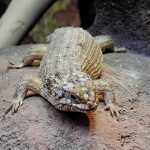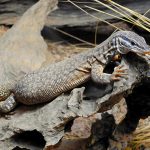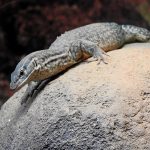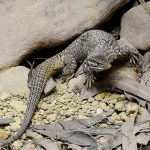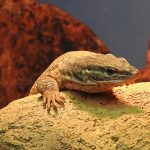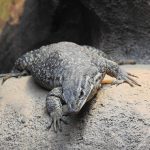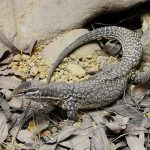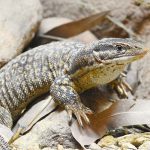SPINY-TAILED MONITOR
(Varanus acanthurus)
The Spiny-tailed Monitor is a remarkable and resilient reptile native to Australia.
As the name suggests, the Spiny-tailed Monitor has a tail that is quite extraordinary. It’s covered in sharp, spiny scales that serve as a formidable defence mechanism. When threatened, this monitor can wedge itself into a crevice and puff up its body to anchor itself in place, making it nearly impossible for predators to extract it. The tail can also be used as a weapon to lash out at threats.
They are relatively small compared to some of their monitor relatives, growing to about 70 cm. in length. They exhibit a robust build with strong limbs and claws, which are excellent for digging and climbing. Their colouration varies from reddish-brown to dark brown with lighter spots or bands, which provides excellent camouflage against the arid landscapes they inhabit.
The Spiny-tailed Monitor is found across the arid regions of Western and Northern Australia. They prefer rocky outcrops and areas with plenty of crevices and hiding spots. These environments not only provide shelter but also a variety of surfaces to bask on, which is essential for these ectotherms to regulate their body temperature.
They are carnivorous, with a diet consisting mainly of insects, spiders, smaller lizards, and occasionally small mammals and birds. Their strong jaws and sharp teeth are perfect for grabbing and dismembering their prey.
When it comes to reproduction, the Spiny-tailed Monitor lays eggs, typically in clutches of around five to ten. They often use termite mounds to incubate their eggs, taking advantage of the stable temperature and humidity within these natural incubators.
They are diurnal creatures, meaning they are active during the day. They are also known for their agility and speed. When foraging or escaping from threats, they can move quickly and with surprising grace.
Currently, the Spiny-tailed Monitor is not considered to be at risk. However, like all wildlife, they face challenges from habitat destruction and invasive species. Conservation efforts continue to be important to ensure their habitats are preserved and that the species remains a thriving part of Australia’s unique ecosystem.
For Indigenous Australians, the Spiny-tailed Monitor holds cultural significance in some regions, featuring in traditional stories and as a food source.
By learning about and appreciating the Spiny-tailed Monitor, we can foster a deeper understanding of the intricate web of life in Australia’s arid regions and the importance of conserving these unique habitats. This small but mighty reptile is yet another example of the incredible adaptability and diversity of Australia’s fauna.
As with all wildlife, it’s crucial to admire lace monitors from a distance, ensuring their natural behaviors are not disrupted. By appreciating these remarkable creatures and their habitats, we can foster a deeper understanding and commitment to protecting the rich tapestry of life that thrives in Australia’s wild places.
.


